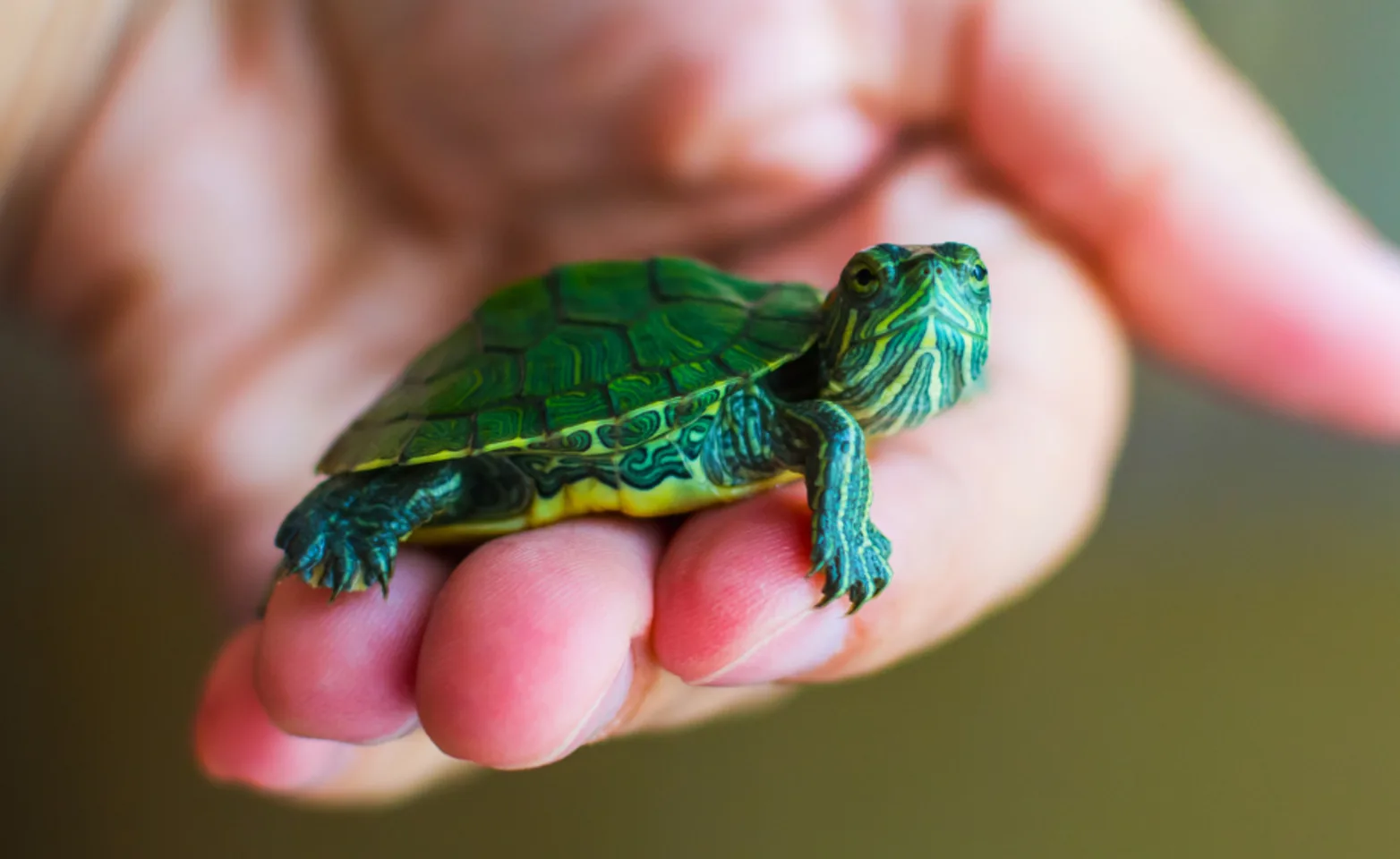Warren Woods Veterinary Hospital

Care and Husbandry
Aquatic turtles are very popular pets. There are many varieties of aquatic turtles some of which include red ear sliders, river cooters, painted turtles and map turtles. These turtles vary in size depending on species but typically range from 10-12 inches in length at maturity. If properly cared for they can live to be 30-80 years old making them a long-term commitment.
Due to the risk of salmonella aquatic turtles with a shell length less than four inches are illegal to sell in the United States unless for educational purposes such as for a classroom. It is also important to thoroughly wash your hands after handling.
Aquatic turtles need a very spacious enclosure. The general rule is 10 gallons of tank per inch of turtle. A 10-20 gallon is sufficient for a young hatchling. The enclosure should consist mostly of water, the water depth should be at least 1.5 to 2 times the length of your turtle. The enclosure must also have a dry “basking” area. This is an area where your turtle can come completely out of the water to bask under its lights. Your turtle may also choose to eat on this basking area.
This area may be created using large rocks or a commercial turtle dock purchased at your local pet supply store. Just be sure that your turtle cannot climb out of its enclosure from the elevated basking area. Turtle enclosures should be kept very clean and a thorough cleaning should be performed weekly or as needed to keep the tank water clean. A large filter, labeled for at least double the size of the tank is necessary to maintain a clean environment. Plants and other decorations can be used to create a more natural looking enclosure but these need to kept clean of algae buildup. Rocks in the bottom of the tank may help minimize leftover food and feces from floating around in the tank, but any rocks should be large enough that your turtle can not fit them in his/her mouth. Rocks or cage decorations that your turtle ingests may lead to intestinal impactions.
Turtle tanks need to be kept above room temperature. The ideal temperature will vary based on specific species but will usually range from 76-85 degrees Fahrenheit. Keeping the water temperature warm can be achieved with the aid of an underwater heater. Just be sure to keep the heater completely submerged while plugged in. When cleaning the enclosure always unplug the heater first if it is not submerged. It is also very important to keep the heater covered with a plastic or metal grate that can be purchased at your local pet supply store; this will keep your turtle from burning itself or breaking the heater. The water temperature is monitored with underwater thermometers. A heat lamp, ceramic heat emitter or specialized aquatic turtle incandescent light bulb is important to keep the air temperature warm over the basking area. The basking area temperature will vary based on specific turtle species but will usually range from 76-85 degrees Fahrenheit. These temperatures are monitored with a thermometer set near the basking area. Your turtle should have 12 hours of daylight (white light) and 12 hours of darkness for their natural biorhythms. A timer purchased from a pet supply store or hardware store can be utilized to maintain this twelve hour light cycle. At night, the temperature in the enclosure should drop slightly, about 10 degrees, as it would in their natural habitat. Night temperatures should also be closely monitored and ceramic heat emitters, red, blue or purple reptile night bulbs can aid in increasing night temperatures if needed. Always use reptile specific heat bulbs which have modifications that benefit the reptile and helps stimulates eating.
An ultraviolet light is essential for the health of turtles. This reptile specific bulb produces UVA and UVB rays and is purchased from your local pet supply store. The UVB rays are important for the natural production of vitamin D which helps the turtle absorb calcium from its diet. Without the UV bulb your turtle cannot properly absorb calcium which leads to metabolic bone disease. UV bulbs for reptiles come in two different forms the compact (coil) bulb and the linear florescent tube. While there are many companies that produce UV bulbs, Zoo Med and Zilla are recommended. Follow manufacturer recommendations to determine the type of UV bulb you purchase, and the distance to place the bulb from your turtle. All UV bulbs need to be changed every 6-12 months based on manufacturer’s recommendations. After that time, even if the bulb still turns on it is not producing the vital rays your turtle needs for calcium metabolism. Plastic and glass windows are designed to block UVB rays so keeping the tank by a window will not provide essential UVB rays. It is ideal to provide monitored time outside on a warm day in an escape proof enclosure with access to shelter. Natural sunlight is the best source of essential UV rays.
Aquatic turtles are omnivores which means that they eat both plants and animals. It is very important to vary their diet; the diet should consist of 50% plant matter, 25% animal protein and 25% commercial diet. Safe foods to offer your turtle include earthworms, slugs, goldfish, guppies, smelt, trout, bloodworms, brine shrimp, crickets, waxworms, mealworms, hornworms and dark leafy greens such as dandelion greens, collard greens, chickory greens, turnip greens, escarole, endive, romaine, kale, mustard, and turnip greens. Fruits such as apples, oranges, carrots, grapes, melons and bananas can be offered. You may also offer commercial aquatic turtle pellets from your local pet store but be sure to offer a variety of pellets. Food may be placed in the water or on the dry basking area. It may be beneficial to feed your turtle in a separate enclosure than your turtle’s main living enclosure to help keep the waste down.
Iceberg lettuce has no nutritional value and should not be fed. Spinach, broccoli, cauliflower, cabbage, and other cruciferous vegetables contain oxalates that bind calcium and reduce its absorption in the body and should not be offered. Hamburger and shellfish are not recommended. An aquatic turtle in the wild would hibernate during the winter to survive the cold weather. You may notice that your turtle eats less and/or becomes less active during the cooler months. This is an instinctual act stimulated by the cooler temperatures and shorter days. Hibernating your turtle can be very dangerous and should only be done by an experienced keeper with help from a reptile veterinarian.
There are many health issues that could affect your turtle. An annual visit to your reptile veterinarian for a thorough physical exam and deworming is important. Some common health that affect aquatic turtles issues may include skin or shell infections, eye infections, respiratory infections, pneumonia, parasites and metabolic conditions caused by calcium and vitamin deficiencies. If you see any changes in your turtle’s behavior or have any concerns about its health it is very important to make an immediate appointment with your veterinarian.
